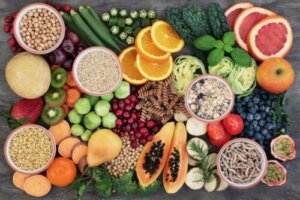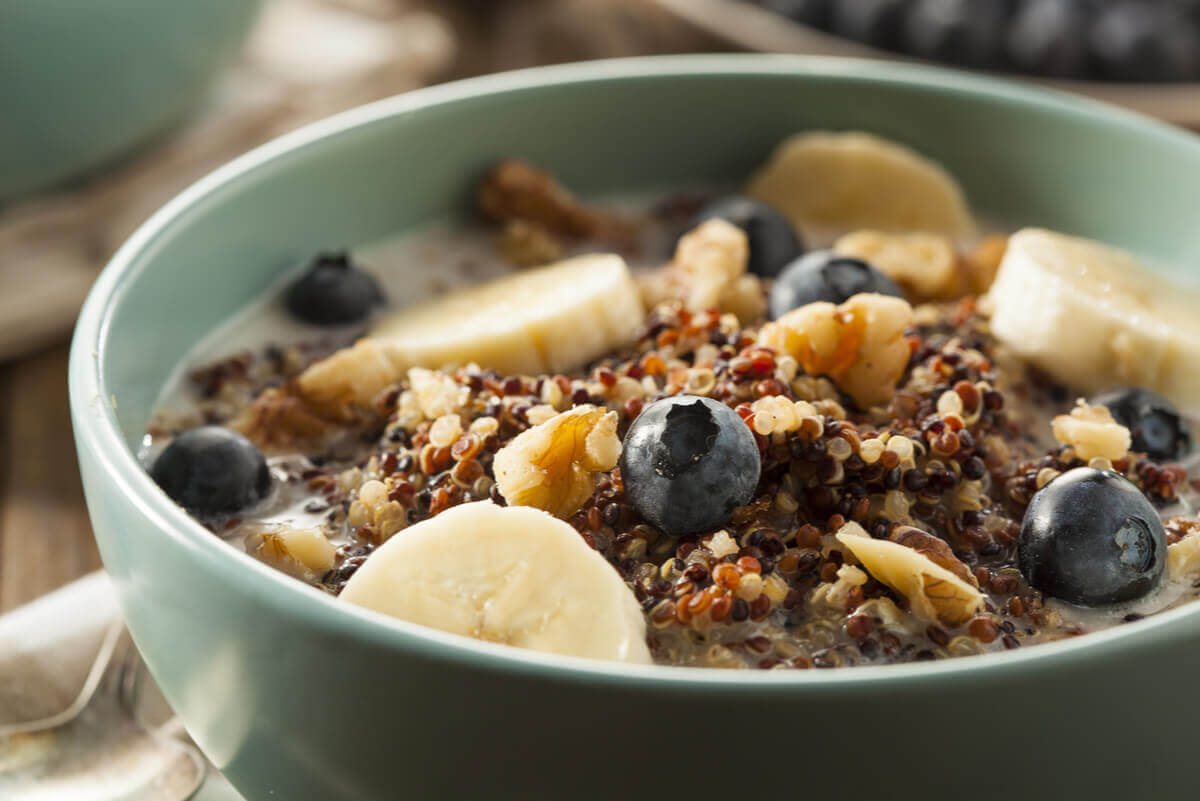What Happens When we Eat Excess Fiber?


Written and verified by the nutritionist Florencia Villafañe
An excess consumption of fiber can cause some complications in the body, although its consumption is almost always beneficial. In any case, we invite you to have a look at the risks of eating an excessive amount of fiber.
Daily consumption of foods that provide fiber is necessary in order to maintain a good overall level of general health. It has a direct positive influence on the regulation of bowel movements and can even improve mood.
Dietary fiber in health
This compound is a good of indigestible substances that are chemically classified as either soluble or insoluble. It is found in vegetables, fruits, leafy greens, grains, and pulses.
As such, many studies have suggested that fiber has a positive contribution to improving the quality of intestinal macrobiotics, prevention of constipation, and illnesses like type 2 diabetes, hypertension, and cancer among others.
Organizations like the World Health Organisation recommend that we eat around 25g of fiber a day.

Cereal is a great source of fiber but when eaten in excess it can be harmful
What happens when we eat excess fiber?
In addition to the fact that our bodies can’t digest this compound, it can also carry substances like cholesterol, some vitamins, and certain minerals, all of which are expelled along with other fecal matter.
This is where some complications may arise after consuming excess fiber. Keep reading to find out more about this in greater detail.
Digestive problems after excess fiber
One of the consequences of having too much fiber in your diet is flatulence and abnormal digestion. This can mean frequent gas in people that are not used to it, which can also happen after eating raw pulses.
Depending on the amount of wind this creates, this can lead to significant annoyances and meteorism (abdominal) pain where the excessive gas accumulates in the gastrointestinal tract.
According to some scientific studies, if your daily consumption of fiber is more than the normal values, in addition to the discomfort mentioned above, you may also experience:
- Soft feces and diarrhea
- Dehydration
- Muscular cramps
- Constipation, due to dehydration
Keep reading: The Foods that Produce the Most Gas
Change in the absorption rate for certain minerals
An excessive and continued consumption of dietary fiber can have an anti-nutrient effect and impact the absorption rate for minerals like calcium, iron, copper, and zinc.
These form insoluble compounds with elements that include fibers, like the phytates in cereals, the tannates in lentils, broad beans, and bananas, and the oxalates in cauliflower and beans. As a result, the metabolism is then affected.
Also have a look at: Iron-Deficiency Anemia Diet: The Foods to Include
A reduced absorption rate for medicines after excess fiber
In addition to what we’ve already mentioned, an excess of fiber in your diet can also have a bad effect on how the body absorbs some medicines like antidepressants, iron supplements, and medications for diabetes or an overactive thyroid like metformin and levothyroxine.
If you take any of these, it’s best to wait 3 or 4 hours before you eat foods that contain fiber. Either way, it’s always best to consult a doctor or nutritionist as they may suggest a more appropriate plan.
Recommendations to avoid an excess of fiber

Abdominal discomfort is one of the effects of excess fiber in your diet.
Generally, we’re advised to consume fiber at a 3:1 ratio, of which the larger amount should be the insoluble variety. Foods that support this are whole grains, beans, peas, and most ripe fruits.
On the other hand, foods like carrots, squashes, dry pulses, plums, and oats contain soluble fiber. For this reason, it’s recommended that you eat a variety of fruit and vegetables.
On that topic, however, nutritionists have created a few practical rules that can help us eat the right amount of fiber. Some of those are:
- 3 portions of vegetables a day
- 2 portions of fruit a day; whole fruit is better than juice
- 6 portions of grains a day; this can be bread, cereal, pasta, or rice as long as they’re wholegrain
- 4 or 5 portions of legumes a week
Excess fibre: what to remember
To combat the symptoms of poor digestion that excess fiber can cause, specialists advise that we sometimes avoid high-fibre products, such as pulses, wholegrain cereals, and raw fruits and vegetables.
Also remember that to prevent dehydration, drinking enough water is essential. In any case, if the annoyances associated with eating too much fiber don’t stop, speak to a medical professional immediately.
All cited sources were thoroughly reviewed by our team to ensure their quality, reliability, currency, and validity. The bibliography of this article was considered reliable and of academic or scientific accuracy.
- Almeida-Alvarado, S. L., Aguilar-López, T., & Hervert-Hernández, D. (2014, June). La fibra y sus beneficios a la salud. In Anales Venezolanos de Nutrición (Vol. 27, No. 1, pp. 73-76). Fundación Bengoa.
- García, O. E., & Rodríguez, C. C. (2011). La educación en nutrición: el caso de la fibra en la dieta. Revista de Investigación, 35(73), 11-24.
- Escudero Álvarez, E., & González Sánchez, P. (2006). La fibra dietética. Nutrición hospitalaria, 21, 61-72.
- Alimentación sana. Organización Mundial de la Salud. Disponible en: https://www.who.int/es/news-room/fact-sheets/detail/healthy-diet.
- Vilcanqui-Pérez, F., & Vílchez-Perales, C. (2017). Fibra dietaria: nuevas definiciones, propiedades funcionales y beneficios para la salud. Revisión. Archivos Latinoamericanos de Nutrición, 67(2), 146-156.
- Pak, Nelly. “La fibra dietética en la alimentación humana, importancia en la salud.” Anales de la Universidad de Chile. No. 11. 2000.
- Villanueva-Flores, Rafael Mauricio. “Fibra dietaria: una alternativa para la alimentación.” Ingeniería Industrial 037 (2019): 229-242.
- Urdampilleta, Aritz, J. M. Martínez-Sanz, and Pedro Gonzalez-Muniesa. “Intervención dietético-nutricional en la prevención de la deficiencia de hierro.” (2010).
- Duarte, Patricia Rayas, and Ana Lourdes Romero Baranzini. “Fibra a base de frutas, vegetales y cereales: función de salud.” Revista mexicana de agronegocios 23 (2008): 613-621.
This text is provided for informational purposes only and does not replace consultation with a professional. If in doubt, consult your specialist.








